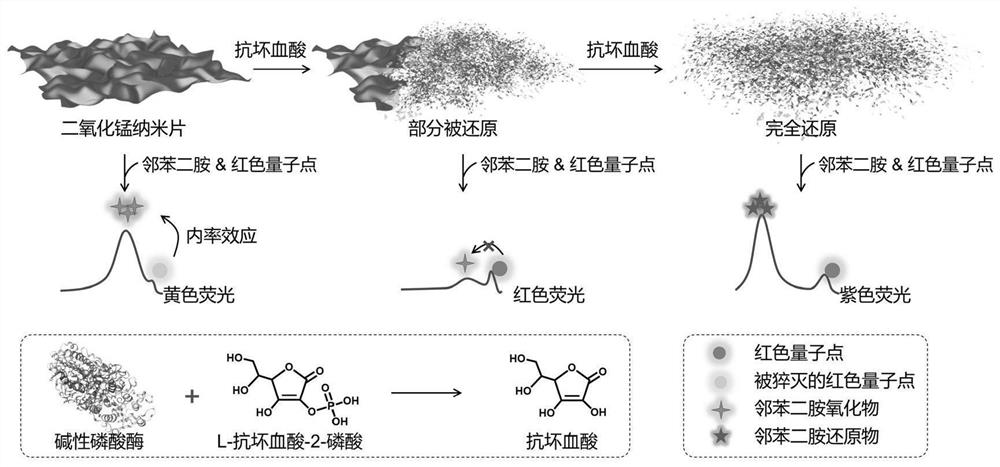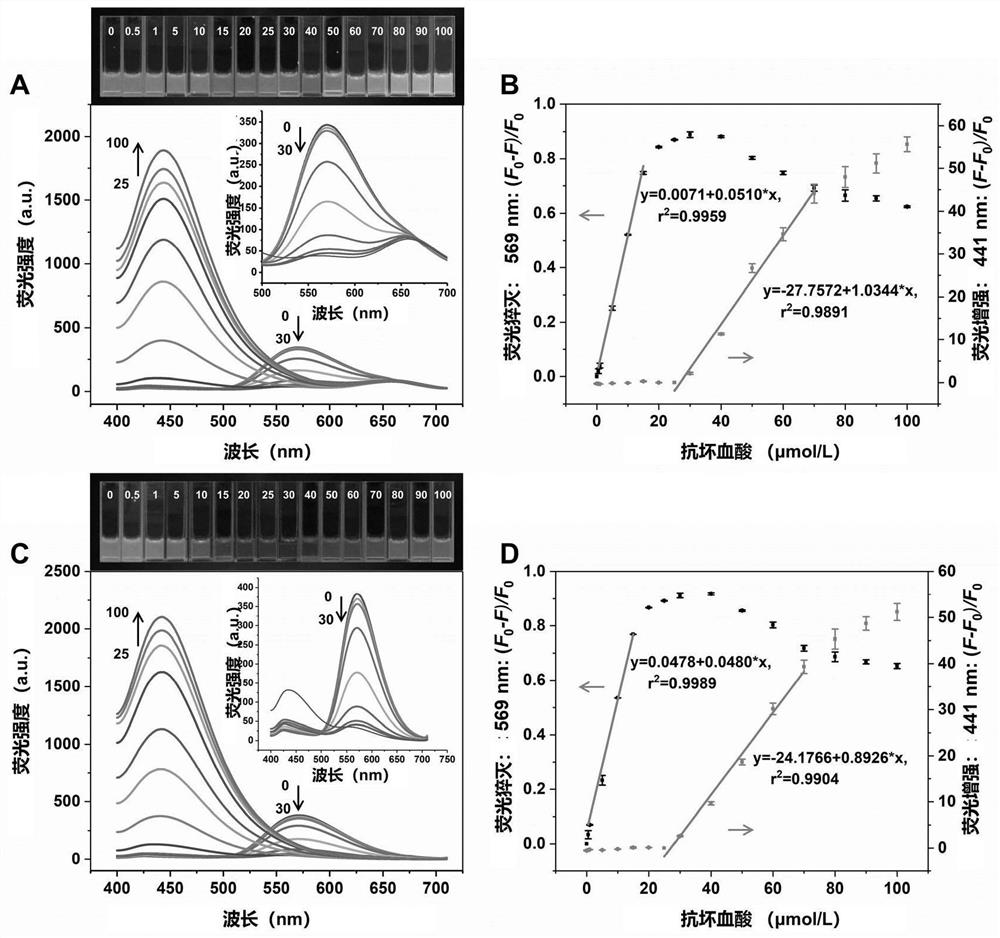A red-yellow-blue three fluorescence emission sensor and its preparation and application
A fluorescence emission and sensor technology, applied in the field of analytical chemistry and rapid detection, can solve the problems of lack of accuracy and precision of visual detection results, limited fluorescence color change range of dual fluorescence emission sensors, etc., to overcome the narrow color evolution range and price. The effect of low cost and simple preparation process
- Summary
- Abstract
- Description
- Claims
- Application Information
AI Technical Summary
Problems solved by technology
Method used
Image
Examples
Embodiment 1
[0037] Preparation of the red-yellow-blue triple fluorescence emission sensor:
[0038] The sensor is composed of manganese dioxide nanosheets, o-phenylenediamine, red fluorescent quantum dots and buffer; the dosage of each substance is: 100 μL manganese dioxide nanosheets (0.8 mg·mL -1 ), 50μL o-phenylenediamine (0.3mol·L -1 ), 20 μL red fluorescent quantum dots; 100 μL phosphate buffer (0.1 mol·L -1 , pH 8.0). And add 750 μL water to volume; when testing samples, add 750 μL sample to volume.
[0039] Or, the sensor is composed of manganese dioxide nanosheets, o-phenylenediamine, red fluorescent quantum dots and a buffer solution containing the substrate L-ascorbic acid-2-phosphate; wherein, the amount of each substance is: 100 μL manganese dioxide nanosheets (0.8 mg·mL -1 ), 50μL o-phenylenediamine (0.3mol·L -1 ), 10 μL red fluorescent quantum dots; 100 μL phosphate buffer (0.1 mol·L -1 , pH 8.0, containing 10 mML-ascorbic acid-2-phosphate). And add 750 μL water to vo...
Embodiment 2
[0043] Accurate visual detection of ascorbic acid using the above sensors:
[0044] see figure 1 : First, 750 μL of ascorbic acid with different concentrations (0, 0.5, 1, 5, 10, 15, 20, 25, 30, 40, 50, 60, 70, 80, 90 and 100 μmol L -1 ) with 100 μL of manganese dioxide nanosheets (0.8 mg·mL -1 ) for 10 minutes, followed by adding 100 μL of phosphate buffer (0.1 mol·L -1 , pH 8.0) and 50 μL o-phenylenediamine (0.3 mol·L -1 ) in a 40°C water bath for 60 minutes. Finally, 20 μL of red fluorescent quantum dots were added, mixed well, and the fluorescence emission spectrum was recorded using a fluorometer at an excitation wavelength of 365 nm and a slit width of 10 / 10 nm, and the corresponding fluorescence images were taken under a 365 nm UV lamp. At the same time, using the same method as above, without adding red fluorescent quantum dots in the preparation process, a yellow-blue dual fluorescent emission sensor was obtained as a control.
[0045] Depend on figure 2 A show...
Embodiment 3
[0047] Accurate visual detection of alkaline phosphatase using the above sensors:
[0048] see figure 1 : First mix 750 μL of alkaline phosphatase with different activities (0, 0.1, 1, 5, 10, 15, 20, 25, 30, 40, 50, 60, 70, 80, 90 and 100 mU / mL) with 100 μL L-ascorbic acid-2-phosphate (10mM, dissolved in 0.1mol·L -1 , pH 8.0 phosphate buffer) in a 37°C water bath for 60 minutes, followed by adding 100 μL of manganese dioxide nanosheets (0.8 mg·mL -1 ) and reacted for 10 minutes, followed by adding 50 μL of o-phenylenediamine (0.3 mol·L -1 ) in a 40°C water bath for 60 minutes. Finally, 10 μL of red fluorescent quantum dots were added, mixed well, and the fluorescence emission spectrum was recorded using a fluorometer at an excitation wavelength of 365 nm and a slit width of 10 / 10 nm, and the corresponding fluorescence images were taken under a 365 nm UV lamp. At the same time, using the same method as above, without adding red fluorescent quantum dots in the preparation pr...
PUM
 Login to View More
Login to View More Abstract
Description
Claims
Application Information
 Login to View More
Login to View More - R&D
- Intellectual Property
- Life Sciences
- Materials
- Tech Scout
- Unparalleled Data Quality
- Higher Quality Content
- 60% Fewer Hallucinations
Browse by: Latest US Patents, China's latest patents, Technical Efficacy Thesaurus, Application Domain, Technology Topic, Popular Technical Reports.
© 2025 PatSnap. All rights reserved.Legal|Privacy policy|Modern Slavery Act Transparency Statement|Sitemap|About US| Contact US: help@patsnap.com



